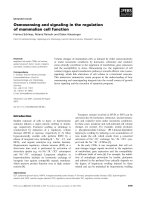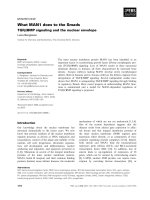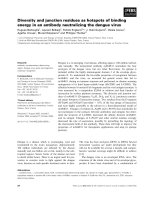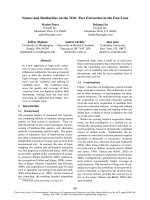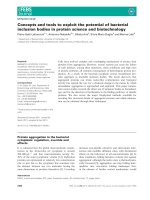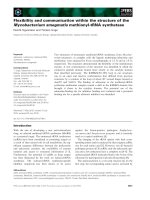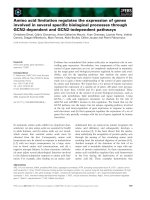cáo khoa học: " Barriers and facilitators to the dissemination of DECISION+, a continuing medical education program for optimizing decisions about antibiotics for acute respiratory infections in primary care: A study protocol" potx
Bạn đang xem bản rút gọn của tài liệu. Xem và tải ngay bản đầy đủ của tài liệu tại đây (268.6 KB, 6 trang )
STUDY PROT O C O L Open Access
Barriers and facilitators to the dissemination of
DECISION+, a continuing medical education
program for optimizing decisions about
antibiotics for acute respiratory infections in
primary care: A study protocol
Anne-Sophie Allaire
1
, Michel Labrecque
1,2
, Anik Giguère
1
, Marie-Pierre Gagnon
1,3
, Jeremy Grimshaw
4
,
France Légaré
1,2*
Abstract
Background: In North America, acute respiratory infections are the main reason for doctors’ visits in primary care.
Family physicians and their patients overuse antibiotics for treating acute respiratory infections. In a pilot clustered
randomized trial, we showed that DECISION+, a continuing medical education program in shared decision making,
has the potential to reduce the overuse of antibiotics for treating acute respiratory infections. DECISION+ learning
activities consisted of three interactive sessions of three hours each, reminders at the point of care, and feedback
to doctors on their agreement with patients about comfort with the decision whether to use antibiotics. The
objective of this study is to identify the barriers and facilitators to physicians’ participation in DECISION+ with the
goal of disseminating DECISION+ on a larger scale.
Methods/design: This descriptive study will use mixed methods and retrospective and prospective components.
All analyses will be based on an adapted version of the Ottawa Model of Research Use. First, we will use qualitative
methods to analyze the following retrospective data from the pilot study: the logbooks of eight research assistants,
the transcriptions of 15 training sessions, and 27 participant evaluations of the DECISION+ training sessions.
Second, we will collect prospective data in semi-structured focus groups composed of family physicians to identify
barriers and facilitators to the dissemination of a future training program similar to DECISION+ . All 39 family
physicians exposed to DECISION+ during the pilot project will be eligible to participate. We will use a self-
administered questionnaire based on Azjen’s Theory of Planned Behaviour to assess participants’ intention to take
part in future training programs similar to DECISION+.
Discussion: Barriers and facilitators identified in this project will guide modifications to DECISION+, a continuing
medical education program in shared decision making regarding the use of antibiotics in acute respiratory
infections, to facilitate its dissemination in primary care on a large scale. Our results should help continuing
medical educators develop a continuing medical education program in shared decision making for other clinically
relevant topics. This will help optimize clinical decisions in primary care.
* Correspondence:
1
Research Center of Centre Hospitalier Universitaire de Québec, Hospital
St-François D’Assise, Knowledge Transfer an Health Technology Assessment
Research Group, 10 rue de l’Espinay, Québec, QC, G1L 3L5, Canada
Full list of author information is available at the end of the article
Allaire et al . Implementation Science 2011, 6:3
/>Implementation
Science
© 2011 Allaire et al; licensee BioM ed Central Ltd. This is a n Open Access article distribut ed under the terms of the Creative Commons
Attribution License ( g/li censes/by/2.0), which permits unrestricted use, distribution, and reproduction in
any medium, provided the original wor k is properly cited.
Background
In 2003, the province of Québec, Canada inaugurated a
provincial public health policy to strengthen residents’
capacity to make decisions regarding their own health [1].
Grounded in patient-centered care and scheduled to run
from 2003 to 2012, this hea lth policy aims to encourage
patients to become more proactive regarding their own
health and to exert full autonomy when making health-
related decisions.
Shared decision making (SDM) could be a way to opera-
tionalize the strategy [2]. SDM can be defined as decisions
that are shared by doctors and patients and that are
informed not only by the best evidence on risks and bene-
fits, but also by patients’ personal characteristics and values.
A systematic review of patient decision aids (also known as
SDM programs) concludes that the aids help improve
patients’ awareness of their options and understanding of
the benefits and disadvan tages of each option [3]. This
makes it easier for patients to make a decision and conse-
quently increases patients’ participation in the decision-
making process.
In spite of the growing interest in SDM, few health pro-
fessionals practice it, and only a few studies on imple-
menting SDM in clinical settings exist [4]. A way to
increasethepracticeofSDMmightbetotrainprofes-
sionals to identify decision points, convey the benefits
and the risks of the options to their patients, and help the
patients clarify their values and preferences [5-8].
Continuing medical education (CME) can be considered
as an important knowledge translation intervention be cause
of its potential to promote clinicians’ adoption of best prac-
tices, including the practices needed for SDM to occur in
primary care [9]. The DECISION+ training program is a
CME program designed to improve family physicians’
knowledge and skills in SDM, in order to optimize the pre-
scription of antibiotics for acute respiratory infections
(ARIs) [10]. ARIs are the principal reason for medical con-
sultations in primary care in North America [11]. Although
the effectiveness of antibiotics in treating most ARIs is lim-
ited, physicians nonetheless prescribed antibiotics for 56%
of adult ARIs and 86% of child ARIs in the United States
from 1995 to 2002 [12,13]. The probabilistic outcomes of
treatments for ARIs and the trade-offs between the benefits
and the harms of antibiotics make it difficult to choose the
best course of action. Because of this uncertainty, patients
should be invited to take part in deciding whether to use
antibiotics for their ARI, and should go through a process
of SDM with their physician if they desire. DECISION+
trains family physicians in SDM and teaches them ways to
share with their patients the decision whether to prescribe
antibiotics for the patient’sARI.
A pilot study conducted in 2007 evaluated the feasibil-
ity and acceptability of DECISION+ in family medicine
clinics [14]. Following the intervention, the physicians
who undertook DECISION+ training program pre-
scribed fewer antibiotics. The reduction was not statisti-
callysignificant,probablybecausethepilotstudywas
underpowered [10]. However, only five of 24 eligible
medical clinics agreed to participate in the pilot study
and 25% of the 39 family physicians enrolled in the
studydidnotcompletetheDECISION+program[15].
Therefore, before disseminating DECISION+, it is essen-
tial not only to perform a larger trial but also to explore
the barriers and facilitators to physicians’ participation.
Identifying barriers and facilitators is a key step to
implementing CME programs successfully in clinical
practice [16]. A systematic review of studies published
in 2004 and 2005 on barriers and facilitators to the
implement ation of SDM in clinical practice identifie d
physicians’ lack of time as the main obstacle [17]. How-
ever, of the 38 articles covered by the review, none stu-
died the barriers and facilitators to the implementation
or dissem ination of CME programs in SDM. In a recent
Cochrane syst ematic review of i nterventions to improve
healthcare professionals’ practice of SDM [4], the only
study that showed a favoura ble impact of a coaching
program with nurse s, also assessed barr iers and facilita-
tors to healthcare professionals’ practice of SDM but
not to its SDM training program [8].
Consequently, the objective of this study is to identify
barriers and facili tators to physicians’ participation in
the DECISION+ training program with the goal of dis-
seminating DECISION+ on a larger scale.
Conceptual framework
The project proposed by this protocol is based on the
Ottawa Model of Research Use’s theory of the mechan-
isms of planned change [18-20] (Figure 1). The Ottawa
Model identifies three principal steps to evaluate how
practitioners’ use of research changes their behaviour:
assessing barriers and facilitators related to practitioners’
use of research; developing and monitoring interven-
tions tailored to those barriers and facilitators; and eval-
uating outcomes. Assess ing barriers and facilitators to
practitioners’ use of research requires investigating t he
relationship between the nature of practitioners’ working
environment, the c haracteristics of the intervention’s
potential future users, a nd the intervention in question
(in this case, DECISION+). Data collection and analysis
for this project will be guided by these three central ele-
ments of knowledge transfer and evidence-based
innovations.
First, to assess barriers and facilitators related to the
pract ice environment, we will gather descriptive data on
potential external influences (e.g., the infrastructure that
houses the family medicine groups (FMGs) whose
Allaire et al . Implementation Science 2011, 6:3
/>Page 2 of 6
personnel participated in our pilot study, the number of
doctors and nurses who work there) and the socioeco-
nomic characteristics of the FMG’s clientele and sur-
rounding area.
Second, we will use Ajzen’ s Theory of Planned Beha-
viour to investigate barriers and facilitators related to
potential future users [21]. Ajzen’ s theory has been
shown to be useful for studying changes in the behaviour
of health professionals [22]. According to the Theory o f
Planned Behaviour, intention is the immediate determi-
nant of behaviour. It is driven by the will of the individual
and is modulated through three direct variables : attitude,
subjective norms, and perceived behavioural control.
Attitude is the subject’s favourable disposition to adopt a
given behaviour. It derives from the consequence s of the
behaviour a nd from positive and negative judgments
about these consequences. Subjective norms are the indi-
vidual’s belief that another person or a group thinks that
he or she should or should not perform the behaviour
[21]. Perceived behavioural control is the belief that a
given factor will increase or reduce the difficulty of per-
forming the behaviour. This last variable has been shown
to be the main obstacle to adopting a behaviour [21].
Third, our study of the barriers and facilitators of the
intervention will be inspired by Rogers’s Diffusion of Inno-
vation Theory [23]. According to Rogers, five elements
determine the diffusion of an intervention: relative advan-
tage, compatibility, complexity, testability, and observabil-
ity. Only the first three of these elements have been shown
to influence the adoption of an intervention [24] and con-
sequently, only those three will be retained here. Relative
advantage refers to the perception that an intervention is
better than current practice. Compatibility measures the
perception that an intervention is consistent with existing
values, past experiments, social practices, and user stan-
dards. Finally, complexity refers to the perception that an
intervention is difficult to include, understand and use.
Methods/design
Study design
This descriptive study will use mixed methods and
include two components. First, retrospective data from
the pilot DECISION+ trial (logbooks, written e valua-
tions, and transcripts of audio recordings) will be quali-
tatively analyzed to identify barriers and facilitators to
the dissemination of DECISION+.
Practice environment
Potential future users
•Attitudes
•Subjective norms
•Perceived behavioural control
Barriers and
facilitators
Evidence-based
intervention
•Relative advantage
•Compatibility
•Complexity
Participation in
DECISION+
Rogers
(1962)
Ajzen
(1991)
Identification + Follow-up
Figure 1 Conceptual framework for the study of barriers and facilitators to the dissemination of DECISION+. Adapted from the Ottawa
Model of Research Use (Logan and Graham, 1998)
Allaire et al . Implementation Science 2011, 6:3
/>Page 3 of 6
Second, 18 months after the completion of the pilot
project, we will collect prospective data from family
physicians from the FMGs who participated in the pilot
project. We will conduct semi-structured focus groups
to gather the physicians’ comments on the program. We
will also distribute a self-administered questionnaire
based on Azjen’s Theory of Planned Behaviour to evalu-
ate physicians’ intention to take part in training pro-
grams similar to DECISION+ in future.
Participants and recruitment strategy
The study population will consist of the 39 family physi-
cians from the five FMGs who took part in our DECI-
SION+ pilot study in Québec, Ca nada, in 2007 and
2008 [10]. We will begin by contacting the person in
charge of the CME activities in each FMG (the contact
person) to plan a meeting during which the researchers
can share the results of pilot study with the physicians
who participated in the pilot. During this presentation,
the researchers will collect physicians ’ comments on
their participation in the pilot. The contact person will
be in charge of advertising the meeting and inviting
physicians to attend. Before the meeting, the focus
group methodology will be pretested and modified as
necessary.
Data collection
The retrospective data consists of recordings of the 15
training workshops conducted in the five FMGs, written
evaluationsoftheworkshopsby27ofthe39original
participants, and the eight logbooks kept by the research
assistants.
For prospective data, we will organize five focus
groups with the family physicians who participated in
our pilot study. By operating with focus groups, we
hope to maximize physicians’ limited availability [25].
Because the lack of time for r esearch is a major barrier
to studying clinicians’ behaviour, each focus group will
be limited to a one-hour session. This may not allow
sufficient time to collect all data. We are conscious of
this limitation and will structureandstandardizeour
data collection process to accommodate the time
allotted. All sessions will be condu cted within the same
interview framework (Additional file 1).
One of t he principal researchers of the pilot project
(ML) will moderate the focus groups. One observer
(ASA) will take notes on the process and the discussion.
This will facilitate the recognition of participants during
the transcription of the discussions.
The focus groups will assess participants’ perceived
barriers and facilitators to take part in a training pro-
gram similar to DECISION+ within the following year.
This program will address clinical topics relevant to par-
ticipants’ practice, other than the use of antibiotics to
treat ARIs. At the end of the focus group, the partici-
pants will be invited to complete a short quantitative
questionnaire that includes f our questions on their
sociodemographic characteristics and 11 questions based
on the Theory of Planned Behaviour that assess their
intention to participate in a future CME program similar
to DECISION+.
Information on the number of doctors and nurses
working in each FMG will be collected from the medical
secretary of each organization. To help make the study
findings transferable and reliable, a research team mem-
ber (ASA) will complete a logbook in which s he will
note any environmental observations (e.g., the type and
location of the FMG), data about the participants (their
number, their reactions), and information on any events
that occur during the course of the interview. She will
also note all modifications to the project and markers of
its evolution.
Data analysis
For the retrospective component of the project, a
resear ch team member will perform a qualitative analys is
of all the material produced during the pilot study. S/he
will use QSR NVivo 8 (QRS International Pty Ltd., Aus-
tralia) to extract and regroup words, expressions, or short
sentences with a view to analyzing the barriers and facili-
tators to physicians’ participating in DECISION+. The
member will produce an analytical report of the material.
For the prospective component of the project, we will
record and trans cribe all focus gro up discussions and
carryoutathematicanalysisusingQSRNVivo8.After
having read and re-read the transcripts, we will apply an
initial open code using deductive analysis based on the
conceptual framework (Figure 1). We will initially cluster
the barriers and facilitators to the use of research within
the three central elements of knowledge transfer and
evidence-based innovation, namely, the practice environ-
ment, potential future users, and the intervention. There-
after, we will conduct an inductive analysis to identify
emergent topics. Data will be coded and analyzed by a
singleperson.Toensuretheconsistency of the qualita-
tive process, preliminary results and the coding scheme
will be discussed with the two members of the research
team who are practicing family physicians (FL, ML). This
will allow us to corroborate the code while protecting the
code from being changed as a result of being applied by
different people.
We will compare the phenomena observed to empha-
sizeacommontangent.Wewillcreatetreestructures
and matrices for the analysis.
We will use descriptive statistics to analyze the socio-
demographic variables, physicians’ participation in the
focus groups and pilot project, observational data, and
answers to our questions based on the Theory of Planned
Allaire et al . Implementation Science 2011, 6:3
/>Page 4 of 6
Behaviour. We will use Pearson’s correlation coefficient
to assess the relationship between the variables from the
questionnaire.
Triangulating the data from the retrospective and the
prospective components of the stud y will enable us to
suggest modifications to DECISION+.
Discussion
Our findings will allow us to adapt and modify the
DECISION+ program in order to facilitate its dissemi-
nation in the practice of primary care. CME is an
important knowledge translation intervention that has
the potential to promote the most effective practices. By
targeting the barriers and the facilitators identified by
the participants in the original DECISION+ pilot study,
our study will allow us to propose modifications to the
programsothatitisbetterdisseminatedonalarger
scale.
It is possible that the SDM skills that physicians
acquire during DECISION+ can be extended to other
health problems encountered in primary care. This
study should help CME producers develop CME pro-
grams in SDM for other clinically relevant topics. This
would help optimize clinical decisions in primary care.
In short, this study will improve our understanding
not only of how DECISION+ can be disseminated, but
also how to d isseminate other CME activities regarding
the practice of SDM in primary care.
Additional material
Additional file 1: Focus group interview framework. Questions ask
during the focus group. -Presentation of the results of the DECISION+
pilot project to participants and invitation to ask questions. -Physicians’
perceptions of the innovations of DECISION+ compared to other CME
programs. -Physicians’ perceptions of factors that could encourage them
to take part in a program similar to DECISION+. -Physicians’ perceptions
of factors that could discourage them from taking part in a program
similar to DECISION+. -Any suggestions or comments to improve
participation in a program similar to DECISION+
Acknowledgements
Funding for the development of this protocol was provided by KT Canada, a
research network funded by a Canadian Institutes of Health Research (CIHR)
grant (Knowledge Translation Canada: A National Research Ne twork
200710CRI-179929-CRI-ADYP-112841). ASA is studying for a master’s degree
in community health. France Légaré holds the Canada Research Chair in
Implementation of Shared Decision Making in Primary Care. AG is a post-
doctoral fellow. ML is a former FRSQ senior clinical scientist. MPG is a CIHR
new investigator. FL, ML, ASA, AG and MPG are members of Knowledge
Translation Canada. JG holds a Canada Research Chair in Health Knowledge
Transfer and Uptake and is the Director of Knowledge Translation Canada. JP
edited the manuscript.
Author details
1
Research Center of Centre Hospitalier Universitaire de Québec, Hospital
St-François D’Assise, Knowledge Transfer an Health Technology Assessment
Research Group, 10 rue de l’Espinay, Québec, QC, G1L 3L5, Canada.
2
Department of Family Medicine and Emergency Medicine, Université Laval,
Pavillon Ferdinand-Vandry, 1050 avenue de la Médecine, Québec, QC, G1V
0A6, Canada.
3
Faculty of Nursing, Université Laval, Pavillon Ferdinand-Vandry,
1050 avenue de la Médecine, Québec, QC, G1V 0A6, Canada.
4
Clinical
Epidemiology Program, Ottawa Health Research Institute and Department of
Medicine, University of Ottawa, 1053 Carling Avenue, Administration
Building, Room 2-017, Ottawa ON K1Y 4E9, Canada.
Authors’ contributions
ASA, FL and ML conceived the study and validated the methods. ASA wrote
the first draft and revised the protocol. FL, ML, AG, JG each reviewed and
modified various versions of the protocol. All authors have read and
approved the final manuscript.
Competing interests
The authors declare that they have no competing interests.
Received: 9 November 2010 Accepted: 7 January 2011
Published: 7 January 2011
References
1. Direction générale de la santé publique du ministère de la Santé et des
Services sociaux: Programme national de santé publique 2003-2012.
Québec; 2003, 134, Direction des communications du ministère de la Santé
et des Services sociaux edition. pp. 134
2. Towle A, Godolphin W: Framework for teaching and learning informed
shared decision making. BMJ 1999, 319:766-771.
3. O’Connor AM, Bennett CL, Stacey D, Barry M, Col NF, Eden KB, Entwistle VA,
Fiset V, Holmes-Rovner M, Khangura S, et al: Decision aids for people
facing health treatment or screening decisions. Cochrane Database Syst
Rev 2009, CD001431.
4. Légaré F, Ratté S, Stacey D, Kryworuchko J, Gravel K, Graham ID, Turcotte S:
Interventions for improving the adoption of shared decision making by
healthcare professionals. Cochrane Database Syst Rev 2010, 5:CD006732.
5. Edwards A, Elwyn G, Hood K, Atwell C, Robling M, Houston H, Kinnersley P,
Russell I: Patient-based outcome results from a cluster randomized trial
of shared decision making skill development and use of risk
communication aids in general practice. Fam Pract 2004, 21:347-354.
6. Elwyn G, Edwards A, Hood K, Robling M, Atwell C, Russell I, Wensing M,
Grol R: Achieving involvement: process outcomes from a cluster
randomized trial of shared decision making skill development and use
of risk communication aids in general practice. Fam Pract 2004,
21:337-346.
7. Légaré F, O’Connor AM, Graham ID, Saucier D, Cote L, Blais J, Cauchon M,
Pare L: Primary health care professionals’ views on barriers and
facilitators to the implementation of the Ottawa Decision Support
Framework in practice. Patient Educ Couns 2006, 63:380-390.
8. Stacey D, O’Connor AM, Graham ID, Pomey MP: Randomized controlled
trial of the effectiveness of an intervention to implement evidence-
based patient decision support in a nursing call centre. J Telemed
Telecare 2006, 12:410-415.
9. Graham ID, Logan J, Harrison MB, Straus SE, Tetroe J, Caswell W,
Robinson N: Lost in knowledge translation: time for a map? J Contin Educ
Health Prof 2006, 26:13-24.
10. Légaré F, Labrecque M, Leblanc A, Njoya M, Laurier C, Cote L, Godin G,
Thivierge RL, O’Connor A, St-Jacques S: Training family physicians in
shared decision making for the use of antibiotics for acute respiratory
infections: a pilot clustered randomized controlled trial. Health Expect
2010.
11. Schappert SM, Rechtsteiner EA: Ambulatory medical care utilization
estimates for 2006. Natl Health Stat Report 2008, 1-29.
12. Roumie CL, Halasa NB, Grijalva CG, Edwards KM, Zhu Y, Dittus RS, Griffin MR:
Trends in antibiotic prescribing for adults in the United States–1995 to
2002. J Gen Intern Med 2005, 20:697-702.
13. Steinman MA, Gonzales R, Linder JA, Landefeld CS: Changing use of
antibiotics in community-based outpatient practice, 1991-1999. Ann
Intern Med 2003, 138:525-533.
14.
Légaré F, Labrecque M, Leblanc A, Thivierge R, Godin G, Laurier C, Cote L,
O’Connor AM, Allain-Boule N, Rousseau J, Tapp S: Does training family
physicians in shared decision making promote optimal use of antibiotics
Allaire et al . Implementation Science 2011, 6:3
/>Page 5 of 6
for acute respiratory infections? Study protocol of a pilot clustered
randomised controlled trial. BMC Fam Pract 2007, 8:65.
15. LeBlanc A, Légaré F, Labrecque M, Godin G, Thivierge R, Laurier C, Côté L,
O’Connor AM, Rousseau M: Feasibility of a randomized trial of a
continuing medical education program in shared decision making on
the use of antibiotics for acute respiratory infections in primary care:
The DECISION + pilot trial. Implement Sci 2011.
16. Koppelaar E, Knibbe JJ, Miedema HS, Burdorf A: Determinants of
implementation of primary preventive interventions on patient handling
in healthcare: a systematic review. Occup Environ Med 2009, 66:353-360.
17. Légaré F, Ratté S, Gravel K, Graham ID: Barriers and facilitators to
implementing shared decision-making in clinical practice: update of a
systematic review of health professionals’ perceptions. Patient Educ
Couns 2008, 73:526-535.
18. Graham ID, Logan J: Innovations in knowledge transfer and continuity of
care. Can J Nurs Res 2004, 36:89-103.
19. Graham K, Logan J: Using the Ottawa Model of Research Use to implement
a skin care program. JNursCareQual2004, 19:18-24, quiz 25-16
20. Logan J, Graham ID: Toward a comprehensive interdisciplinary model of
health care research use. Science Communication 1998, 20:227-247.
21. Ajzen I: The theory of planned behavior. Organizational Behavior and
Human Decision Processes 1991, 50:179-211.
22. Godin G, Belanger-Gravel A, Eccles M, Grimshaw J: Healthcare
professionals’ intentions and behaviours: A systematic review of studies
based on social cognitive theories. Implement Sci 2008, 3:36.
23. Rogers EM: Diffusion of innovations. Fourth edition. New York: The Free
Press; 1995.
24. Tornatzky L, Klein K: Innovation characteristics and innovation adoption-
implementation: A meta-analysis of findings. IEEE Transactions on
engineering management 1982, 29:28-45.
25. Paillé P, Mucchielli A: L’analyse qualitative en sciences humaines et sociales
Armand Colin edn. Paris; 2008.
doi:10.1186/1748-5908-6-3
Cite this article as: Allaire et al.: Barriers and facilitators to the
dissemination of DECISION+, a continuing medical education program
for optimizing decisions about antibiotics for acute respiratory
infections in primary care: A study protocol. Implementation Science 2011
6:3.
Submit your next manuscript to BioMed Central
and take full advantage of:
• Convenient online submission
• Thorough peer review
• No space constraints or color figure charges
• Immediate publication on acceptance
• Inclusion in PubMed, CAS, Scopus and Google Scholar
• Research which is freely available for redistribution
Submit your manuscript at
www.biomedcentral.com/submit
Allaire et al . Implementation Science 2011, 6:3
/>Page 6 of 6
